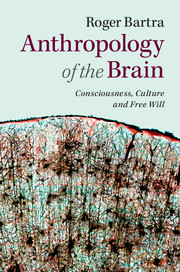Book contents
- Frontmatter
- Contents
- Preface
- Part I Consciousness and symbolic systems
- 1 The hypothesis
- 2 Evolution of the brain
- 3 Brain plasticity
- 4 Is there an internal language?
- 5 Amputations and supputations
- 6 The atrophied exocerebrum
- 7 The symbolic substitution system
- 8 Neuronal mirrors
- 9 Consciousness within hand’s reach
- 10 Outside and inside: the immense blue
- 11 The musical spheres of consciousness
- 12 Artificial memory
- 13 The lost soul
- Part II Brain and free will
- Bibliography
- Index
7 - The symbolic substitution system
Published online by Cambridge University Press: 05 June 2014
- Frontmatter
- Contents
- Preface
- Part I Consciousness and symbolic systems
- 1 The hypothesis
- 2 Evolution of the brain
- 3 Brain plasticity
- 4 Is there an internal language?
- 5 Amputations and supputations
- 6 The atrophied exocerebrum
- 7 The symbolic substitution system
- 8 Neuronal mirrors
- 9 Consciousness within hand’s reach
- 10 Outside and inside: the immense blue
- 11 The musical spheres of consciousness
- 12 Artificial memory
- 13 The lost soul
- Part II Brain and free will
- Bibliography
- Index
Summary
I do not claim that the vast social and cultural structures are a giant exocerebrum, a colossal prosthesis composed of endless symbolic circuits. Such a lax definition loses explanatory strength and hurls us into the abyss of the commonplace and the obvious. Nonetheless, it seems the immense vastness of culture does not contain all the secrets of its structure and evolution. The studies of anthropologists, historians, linguists, sociologists, and psychologists have constantly shown the need to turn to metasocial explanations in order to complete the interpretation of cultural phenomena. I am not referring only to the search for religious and metaphysical paths. The tendencies to look for answers in the social mentalities, the collective unconscious, archetypes, natural selection, genes, or the structure of the brain are more significant. In my opinion, these concerns are reactions to a real problem that is difficult to solve. There seems to me to be an incompleteness in sociocultural structures that is especially notorious in myths, symbolic language, visual imagery, or kinship relations that is similar to the incompleteness I believe exists in certain neuronal circuits. But the search for extracultural “causes” or “origins” has come up against many difficulties for creating an explanatory model capable of unifying biological and cultural structures. It would appear that we are facing worlds that are just as unconquerable as theological mysteries and secular realities tend to be. Perhaps it would be more creative to stop looking for a metacultural or extrasocial causality and instead confront the problem of deciphering a web of interactions that has its own dynamic: the network that joins the brain with the exocerebrum. To bolster these searches and reflections, I will make use of ideas developed by neurologists, biologists, and psychologists who have explored the world of culture.
- Type
- Chapter
- Information
- Anthropology of the BrainConsciousness, Culture, and Free Will, pp. 43 - 50Publisher: Cambridge University PressPrint publication year: 2014



